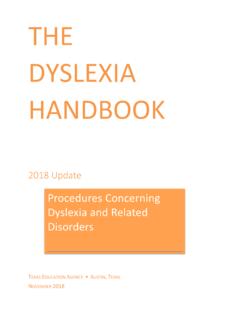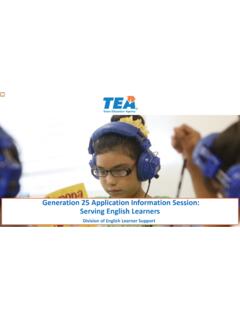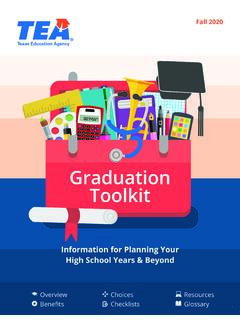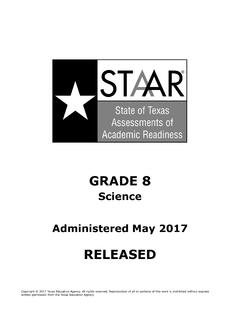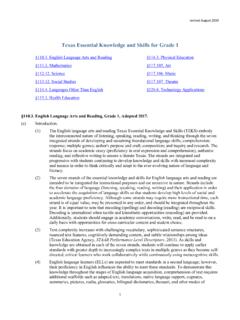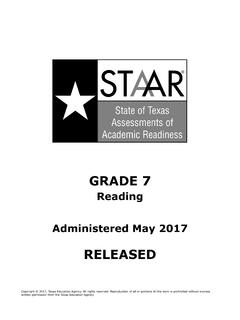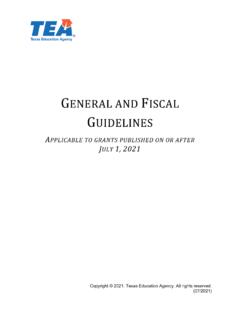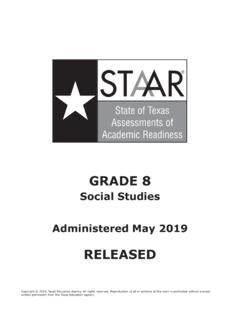Transcription of Texas Essential Knowledge and Skills for Kindergarten
1 Revised August 2017 1 Texas Essential Knowledge and Skills for Kindergarten English Language Arts and Reading Mathematics Science Social Studies Languages Other Than English Health Education Physical Education Art Music Theatre Technology Applications English Language Arts and Reading, Kindergarten , Beginning with School Year 2009-2010. (a) Introduction. (1) The English Language Arts and Reading Texas Essential Knowledge and Skills (TEKS) are organized into the following strands: Reading, where students read and understand a wide variety of literary and informational texts ; Writing, where students compose a variety of written texts with a clear controlling idea, coherent organization, and sufficient detail; Research, where students are expected to know how to locate a range of relevant sources and evaluate, synthesize, and present ideas and information.
2 Listening and Speaking, where students listen and respond to the ideas of others while contributing their own ideas in conversations and in groups; and Oral and Written Conventions, where students learn how to use the oral and written conventions of the English language in speaking and writing. The Reading strand is structured to reflect the major topic areas of the National Reading Panel Report. In Kindergarten , students engage in activities that build on their natural curiosity and prior Knowledge to develop their reading, writing, and oral language Skills .
3 (2) For students whose first language is not English, the students' native language serves as a foundation for English language acquisition. (A) English language learners (ELLs) are acquiring English, learning content in English, and learning to read simultaneously. For this reason, it is imperative that reading instruction should be comprehensive and that students receive instruction in phonemic awareness, phonics, decoding, and word attack Skills while simultaneously being taught academic vocabulary and comprehension Skills and strategies. Reading instruction that enhances ELL's ability to decode unfamiliar words and to make sense of those words in context will expedite their ability to make sense of what they read and learn from reading.
4 Additionally, developing fluency, spelling, and grammatical conventions of academic language must be done in meaningful contexts and not in isolation. (B) For ELLs, comprehension of texts requires additional scaffolds to support comprehensible input. ELL students should use the Knowledge of their first language ( , cognates) to further vocabulary development. Vocabulary needs to be taught in the revised August 2017 2 context of connected discourse so that language is meaningful. ELLs must learn how rhetorical devices in English differ from those in their native language.
5 At the same time English learners are learning in English, the focus is on academic English, concepts, and the language structures specific to the content. (C) During initial stages of English development, ELLs are expected to meet standards in a second language that many monolingual English speakers find difficult to meet in their native language. However, English language learners' abilities to meet these standards will be influenced by their proficiency in English. While English language learners can analyze, synthesize, and evaluate, their level of English proficiency may impede their ability to demonstrate this Knowledge during the initial stages of English language acquisition.
6 It is also critical to understand that ELLs with no previous or with interrupted schooling will require explicit and strategic support as they acquire English and learn to learn in English simultaneously. (3) To meet Public Education Goal 1 of the Texas Education Code, , which states, "The students in the public education system will demonstrate exemplary performance in the reading and writing of the English language," students will accomplish the Essential Knowledge , Skills , and student expectations at Kindergarten as described in subsection (b) of this section.
7 (4) To meet Texas Education Code, (h), which states, ".. each school district shall foster the continuation of the tradition of teaching United States and Texas history and the free enterprise system in regular subject matter and in reading courses and in the adoption of textbooks," students will be provided oral and written narratives as well as other informational texts that can help them to become thoughtful, active citizens who appreciate the basic democratic values of our state and nation. (b) Knowledge and Skills . (1) Reading/Beginning Reading Skills /Print Awareness.
8 Students understand how English is written and printed. Students are expected to: (A) recognize that spoken words can be represented by print for communication; (B) identify upper- and lower-case letters; (C) demonstrate the one-to-one correspondence between a spoken word and a printed word in text; (D) recognize the difference between a letter and a printed word; (E) recognize that sentences are comprised of words separated by spaces and demonstrate the awareness of word boundaries ( , through kinesthetic or tactile actions such as clapping and jumping).
9 (F) hold a book right side up, turn its pages correctly, and know that reading moves from top to bottom and left to right; and revised August 2017 3 (G) identify different parts of a book ( , front and back covers, title page). (2) Reading/Beginning Reading Skills /Phonological Awareness. Students display phonological awareness. Students are expected to: (A) identify a sentence made up of a group of words; (B) identify syllables in spoken words; (C) orally generate rhymes in response to spoken words ( , "What rhymes with hat?"); (D) distinguish orally presented rhyming pairs of words from non-rhyming pairs; (E) recognize spoken alliteration or groups of words that begin with the same spoken onset or initial sound ( , "baby boy bounces the ball"); (F) blend spoken onsets and rimes to form simple words ( , onset/c/ and rime/at/ make cat); (G) blend spoken phonemes to form one-syllable words ( ,/m/.)
10 /a/ ../n/ says man); (H) isolate the initial sound in one-syllable spoken words; and (I) segment spoken one-syllable words into two to three phonemes ( , dog:/d/ ../o/ ../g/). (3) Reading/Beginning Reading Skills /Phonics. Students use the relationships between letters and sounds, spelling patterns, and morphological analysis to decode written English. Students are expected to: (A) identify the common sounds that letters represent; (B) use Knowledge of letter-sound relationships to decode regular words in text and independent of content ( , VC, CVC, CCVC, and CVCC words); (C) recognize that new words are created when letters are changed, added, or deleted; and (D) identify and read at least 25 high-frequency words from a commonly used list.
